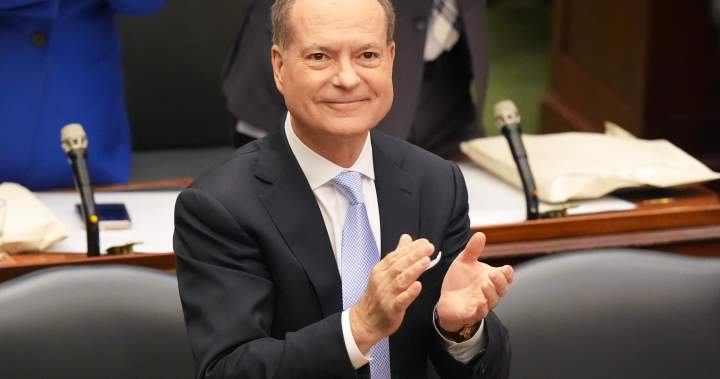Ontario is facing an increasingly dire economic future as the impacts of tariffs from the United States continue to bite, with the government revising down its estimates for growth, job creation and the housing market.

Finance Minister Peter Bethlenfalvy tabled his Fall Economic Statement on Thursday afternoon with a smattering of minor policy changes dominated by the grim provincial outlook.
“As a province and a country, we find ourselves in the midst of trade uncertainty that we did not ask to be a part of, causing anxiety for workers and businesses alike,” he is set to tell the house.
Since the budget was tabled less than six months ago, in mid-May, the government’s job creation projects have been revised down from 73,000 to 70,000. Next year, the province is expected to see 35,000 new jobs created, up from 33,000 in the previous projection.
Story continues below advertisement
Over the next four years, the government has revised job creation down by a total of 1,000 — with 3,000 fewer this year and 8,000 fewer than expected in 2027.
The numbers for 2026 and 2028 have been updated upwards.
The unemployment rate has been revised to worsen from 7.6 to 7.8 per cent and is predicted to remain higher than the 2025 budget forecast through to 2028.
“Employment growth is projected to ease further in 2026 to 0.4 per cent as economic growth continues to be impacted by the ongoing trade conflicts and the effect of the associated uncertainty on investment and hiring,” the document said.
More on Politics
More videos
Young workers, it added, “have been particularly affected.”
According to the government’s website, more than 700,000 people are unemployed in Ontario.
The province’s worsening jobs record is something opposition critics have increasingly focused on, with Ontario NDP Leader Marit Stiles referring to Premier Doug Ford as a “jobs disaster.”

Get breaking National news
For news impacting Canada and around the world, sign up for breaking news alerts delivered directly to you when they happen.
The jab is one of the few opposition questions the premier has stood up and responded to since the legislature returned in mid-October. Generally, Ford has allowed his ministers to field questions, criticisms and calls for their resignation.
“Hundreds and hundreds of thousands of Ontarians are unemployed already and we haven’t even really felt the hit from the tariffs,” Stiles said on Wednesday.
Story continues below advertisement
“Working people are waking up every morning and going, ‘Do I have a job to go to? Is there going to be a sign on the plant when I get to work today?’”
The government said that, while the year began positively for jobs, things worsened in the second quarter.
“Industries particularly impacted by U.S. tariffs, such as manufacturing, transportation and warehousing, contributed to the second quarter employment decline,” the province wrote.
Ministry of Finance officials said experts of autos and steel, in particular, had been impacted by tariffs from the United States.
Statistics Canada data for September shows Ontario had a 7.9 per cent unemployment rate, compared to a national rate of 7.1 per cent.
Despite the predictions, the Fall Economic Statement promised the government would take action to stem the bleeding.
“Ontario is prepared to do whatever it takes to provide critical financial supports to protect Ontario workers and jobs,” the document states, touting up to $30 billion it says has been announced as tariff-related money.
The economic uncertainty could throw Ontario off its path to balance in the worst-case scenario, though the government is still planning to post a surplus in 2027-28. Its predicted deficit for the current year is roughly a billion less than expected, while next year and the year after are unchanged.
Trending Now

Budget 2025 made some changes to tax policy. What does it mean for you?

Miss Universe walkout: Scandal erupts after Miss Mexico called ‘dumb’
Story continues below advertisement
Real GDP growth is expected to almost come to a stop over the next few years.
The government expects it to record 0.8 per cent real GDP growth this year and 0.9 per cent next year, rising to 1.8 per cent in 2027. In a slow-growth scenario, it could be negative 0.3 next year.
Despite the bleak employment outlook, some indicators are still positive.
Revenues are up $3.2 billion over the projections in the 2025 budget, something the government attributes to strong tax revenue and money from the public sector. Program expenses are also up, though by less than revenue.
Tax rebates and electoral changes
Elsewhere, while the economic statement is being pushed as an update rather than a mini-budget, the government confirmed a number of policy changes.
Story continues below advertisement
The document confirms Ontario will rebate its portion of the harmonized sales tax for first-time homebuyers, a move it has promised could save buyers up to $80,000.
To qualify for the rebate, people must be buying a new home to be their main residence. Combined with a similar federal initiative, it could save homebuyers the full 13 per cent sales tax.
The government is expecting to spend $470 million on the initiative over three years: $35 million this year, $190 million next year and $245 million for the 2027-28 year.
The legislation tabled for the fall economic statement also includes major changes to election laws in Ontario.
The changes, if passed, would abolish fixed-term election dates in Ontario, allowing the current government to sit for a full constitutional five-year term.
It would also almost double the annual limits on what someone can donate to a political party, make the per-vote subsidy for parties permanent and eliminate spending restrictions on third-party advocacy groups.

